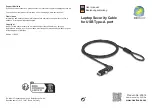
To use advanced startup options, do the following:
Note:
The GUI items of the operating system might change without notice.
1. Open the Start menu and then click
Settings
. If
Settings
is not displayed, click
All apps
to display all
programs, and then click
Settings
➙
Update & security
➙
Recovery
.
2. In the
Advanced startup
section, click
Restart now
➙
Troubleshoot
➙
Advanced options
.
3. Select a desired startup option, then follow the instructions on the screen.
Recovering your operating system if Windows 10 fails to start
The Windows recovery environment on your computer is capable of operating independently from the
Windows 10 operating system. This enables you to recover or repair the operating system even if the
Windows 10 operating system fails to start.
After two consecutive failed boot attempts, the Windows recovery environment starts automatically. Then
you can choose repair and recovery options by following the instructions on the screen.
Note:
Ensure that your computer is connected to ac power during the recovery process.
Creating and using a recovery USB drive
You can create a recovery USB drive as a backup for the Windows recovery programs. With the recovery
USB drive, you can troubleshoot and fix the problems even if the preinstalled Windows recovery programs
are damaged.
Creating a recovery USB drive
The USB drive that you use to create the recovery USB drive must be at least 16 GB of storage. The actual
USB capacity that is required depends on the size of the recovery image.
Attention:
The creation process deletes anything stored on the USB drive. To avoid data loss, make a
backup copy of all the data that you want to keep.
To create a recovery USB drive, do the following:
Note:
Ensure that your computer is connected to ac power during the following process.
1. Connect a proper USB drive (at least 16 GB of storage).
2. Type
recovery
in the search box on the taskbar. Then click
Create a recovery drive
.
3. Click
Yes
in the User Account Control window to allow the Recovery Media Creator program to start.
4. In the Recovery Drive window, follow the on-screen instructions to create a recovery USB drive.
Using the recovery USB drive
If you cannot start your computer, refer to the corresponding information in the topic “Troubleshooting” on
page 89 to try to solve the problem by yourself. If you still cannot start your computer, use the recovery
USB drive to recover your computer.
To use a recovery USB drive, do the following:
Note:
Ensure that your computer is connected to ac power.
1. Connect the recovery USB drive to the computer.
2. Turn on or restart the computer. Before the Windows operating system starts, repeatedly press the F12
key. The Boot Menu window opens.
3. Select the recovery USB drive as the boot device.
.
115
Summary of Contents for ThinkPad T460p
Page 1: ...ThinkPad T460p User Guide ...
Page 6: ...iv ThinkPad T460p User Guide ...
Page 16: ...Save these instructions xiv ThinkPad T460p User Guide ...
Page 60: ...44 ThinkPad T460p User Guide ...
Page 78: ...62 ThinkPad T460p User Guide ...
Page 104: ...88 ThinkPad T460p User Guide ...
Page 124: ...108 ThinkPad T460p User Guide ...
Page 156: ...140 ThinkPad T460p User Guide ...
Page 160: ...144 ThinkPad T460p User Guide ...
Page 172: ...China RoHS 156 ThinkPad T460p User Guide ...
Page 176: ...160 ThinkPad T460p User Guide ...
Page 179: ......
Page 180: ......
















































